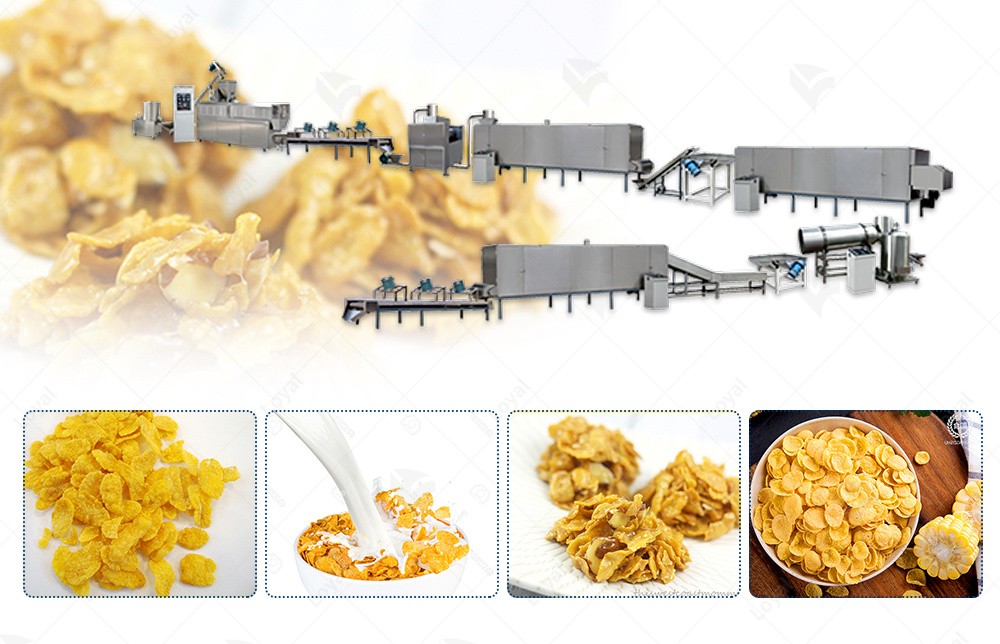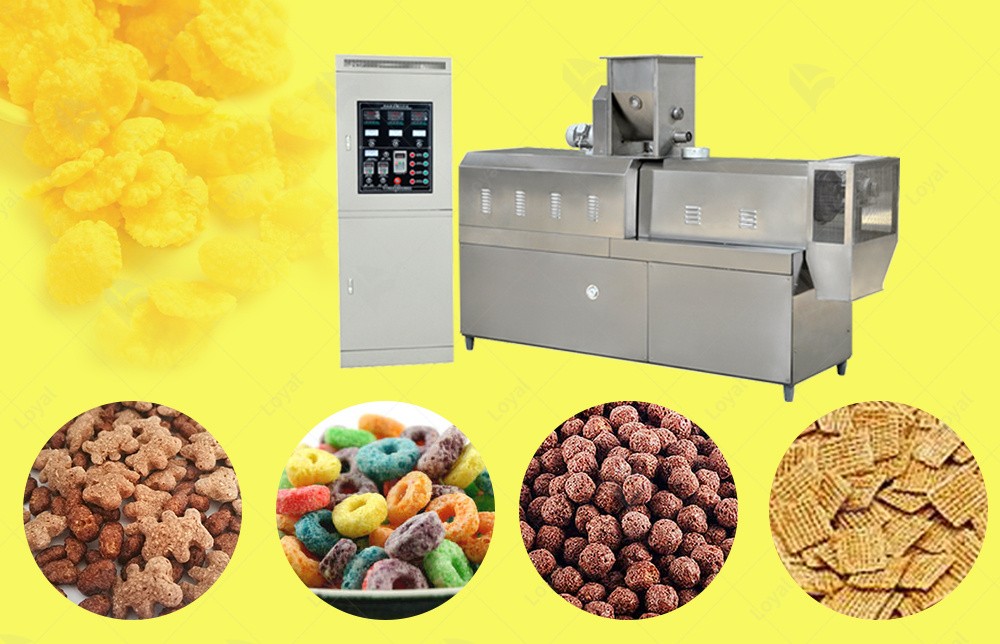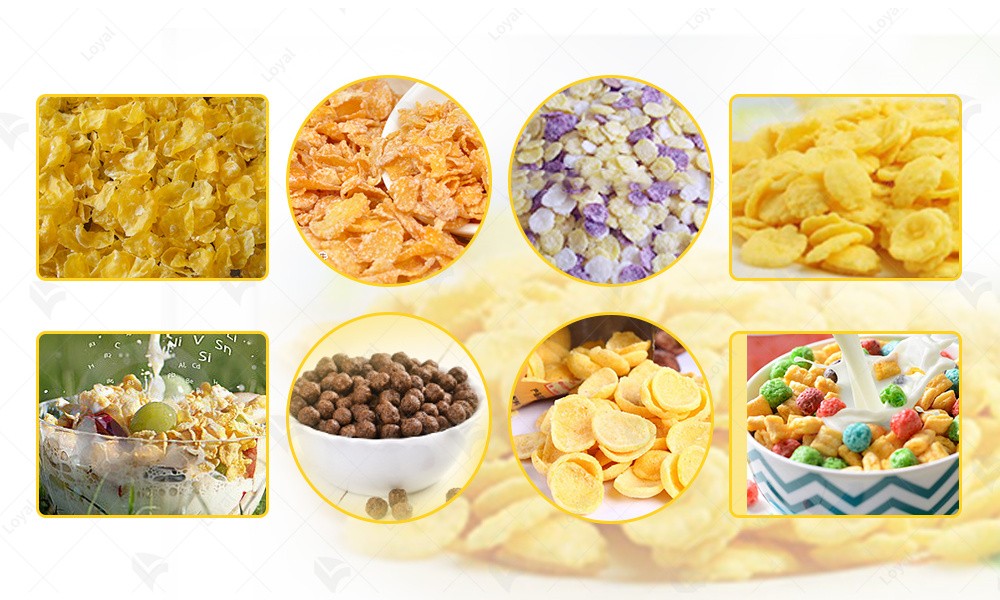
- Shandong Loyal Industrial Co.,Ltd.
- Macaroni Production Machine Instant Noodle Machine Biscuit Making Machine
Home> Company News> The Ultimate Guide to Cereal Flakes Production Line in 2024

The Ultimate Guide to Cereal Flakes Production Line in 2024
2024-07-03 10:45:26Introduction
The Cereal Flakes Production Line is a crucial component of the modern food industry, playing a significant role in the manufacturing of one of the world's most popular breakfast foods. In 2024, the industry continues to evolve with technological advancements and increased demand for high-quality, nutritious products. This guide aims to provide a comprehensive overview of the Cereal Flakes Production Line, highlighting its importance, the latest innovations, and best practices.
Cereal flakes, known for their crisp texture and convenience, are a staple in many households. They are produced through a series of carefully controlled processes that ensure consistency and quality. The Cereal Flakes Production Line encompasses several stages, including raw material handling, cooking, flaking, drying, cooling, and packaging. Each stage is critical to maintaining the nutritional value and appealing texture of the final product.
In 2024, the focus is not only on efficiency and production speed but also on sustainability and energy efficiency. Modern production lines are designed to minimize waste and reduce energy consumption, aligning with global trends towards greener manufacturing practices. Additionally, automation and advanced monitoring systems have become integral to the production process, ensuring high standards of quality control and reducing human error.
As consumer preferences shift towards healthier and more customized options, the Cereal Flakes Production Line must adapt to produce a variety of cereal flakes that cater to these demands. This includes incorporating whole grains, fortifying products with vitamins and minerals, and developing new flavors and textures to meet diverse tastes.
This guide will delve into each aspect of the Cereal Flakes Production Line, providing detailed insights and practical advice for setting up and optimizing production processes. Whether you are an industry professional or a newcomer looking to understand the intricacies of cereal flakes manufacturing, this guide will serve as a valuable resource.

Types of Cereal Flakes
Understanding the different types of cereal flakes is fundamental for optimizing the Cereal Flakes Production Line. The variety in cereal flakes caters to diverse consumer preferences and dietary needs, which has become increasingly important in 2024.
Corn Flakes
Corn flakes are the most well-known type of cereal flakes. Made from milled corn, these flakes are cooked, flattened, and toasted to achieve their crisp texture. The production line for corn flakes involves precise control of cooking temperatures and flaking processes to ensure uniformity and quality. The popularity of corn flakes is due to their simplicity, versatility, and nutritional value.
Wheat Flakes
Wheat flakes are another staple in the cereal aisle, known for their hearty texture and rich nutritional profile. These flakes are produced from whole wheat grains, which are cooked, rolled, and toasted. The Cereal Flakes Production Line for wheat flakes requires specialized equipment to handle the denser grain and ensure even cooking and flaking. Wheat flakes are favored for their high fiber content and health benefits.
Rice Flakes
Rice flakes offer a lighter, more delicate option among cereal flakes. Produced from rice grains, these flakes undergo a similar process of cooking, flattening, and drying. The production line must maintain gentle handling to preserve the integrity of the rice grains. Rice flakes are often used in gluten-free cereals and are appreciated for their crisp texture and subtle flavor.
Multi-Grain Flakes
Multi-grain flakes combine several types of grains, such as oats, barley, and rice, to create a nutritionally diverse product. The Cereal Flakes Production Line for multi-grain flakes is more complex, requiring careful blending and cooking of different grains to achieve a uniform flake. This type of cereal flake is increasingly popular due to its enhanced nutritional profile and unique flavor combinations.
Specialty Flakes
Specialty flakes include a variety of innovative products designed to meet specific dietary trends and consumer preferences. These might include organic flakes, protein-fortified flakes, or those infused with fruits and nuts. The Cereal Flakes Production Line for specialty flakes must be adaptable to handle different ingredients and processing requirements. This flexibility is crucial for staying competitive in a market that values customization and health-oriented products.

Key Components of a Cereal Flakes Production Line
|
Component |
Function |
|
Raw Material Handling and Storage |
Manages the intake, cleaning, and storage of raw materials such as corn, wheat, or rice. Ensures materials are free from contaminants and stored in optimal conditions to maintain quality. |
|
Mixers |
Combine various ingredients to create a homogeneous mixture. This step is critical for maintaining consistency in flavor and texture. |
|
Cookers |
Cook the raw grains to the desired texture and moisture content. The cooking process can be adjusted based on the type of grain being used. |
|
Flaking Machines |
Flatten cooked grains into thin flakes. These machines must apply uniform pressure to ensure even flaking, which is crucial for texture and quality. |
|
Drying Systems |
Remove excess moisture from the flakes to achieve the desired crispness. Efficient drying systems are vital for maintaining product shelf life. |
|
Cooling Systems |
Cool the flakes to prevent condensation and maintain their crisp texture. Cooling must be done uniformly to avoid any textural inconsistencies. |
|
Packaging Machinery |
Automatically pack the finished cereal flakes into boxes or bags. Modern packaging machinery often includes features for vacuum sealing and labeling. |
|
Quality Control Systems |
Monitor various parameters throughout the production process, including moisture content, flake size, and packaging integrity. These systems ensure that the final product meets all quality standards. |
|
Automation and Monitoring |
Advanced software and sensors automate and monitor the entire production line, increasing efficiency and reducing human error. Real-time data analysis helps in making immediate adjustments to maintain optimal production conditions. |

Step-by-Step Production Process
1. Grain Preparation and Cleaning
The first step in the Cereal Flakes Production Line involves the preparation and cleaning of raw grains. This is crucial for removing impurities such as stones, dirt, and other foreign materials. Advanced cleaning machines use air, magnets, and screens to ensure the grains are thoroughly cleaned, thus maintaining the quality and safety of the final product.
2. Cooking
Once cleaned, the grains are transferred to cookers. Cooking is a critical phase where grains are subjected to specific temperatures and moisture levels to achieve the desired softness and moisture content. This step is essential for ensuring the grains can be properly flaked in the subsequent stages. The use of modern cookers allows for precise control over cooking conditions, ensuring consistency across batches.
3. Flaking
After cooking, the grains are directed to flaking machines. These machines apply pressure to flatten the grains into thin flakes. The flaking process is pivotal for achieving the characteristic texture of cereal flakes. Uniform pressure and advanced rollers are used to ensure the flakes are even and consistent in thickness, which is important for quality and consumer satisfaction.
4. Drying
The flaked grains then enter drying systems, where excess moisture is removed to achieve the desired crispness. Proper drying is essential to prevent spoilage and extend the shelf life of the cereal flakes. Modern drying systems use controlled air flows and temperatures to ensure the flakes are dried uniformly and efficiently.
5. Cooling
Post-drying, the flakes are cooled to room temperature. Cooling is a necessary step to prevent condensation when the flakes are packaged. Effective cooling systems are designed to cool the flakes quickly and uniformly, preserving their texture and preventing any degradation of quality.
6. Packaging
The final step in the Cereal Flakes Production Line is packaging. Automated packaging machines fill the cereal flakes into pre-set packaging forms, such as boxes or bags. These machines often include features like vacuum sealing and labeling, ensuring the flakes remain fresh and are presented attractively to consumers. Proper packaging is vital for protecting the product during transportation and storage.

Technological Innovations in 2024
1. Automation in Production Lines
One of the most significant advancements in the Cereal Flakes Production Line in 2024 is the integration of automation. Automation technologies, including robotic arms and automated conveyor systems, have streamlined the production process, reducing human error and increasing efficiency. These systems can handle repetitive tasks with precision, ensuring consistent quality in every batch of cereal flakes. Automated systems also allow for real-time monitoring and adjustments, enhancing overall productivity.
2. Energy Efficiency and Sustainability
In 2024, there is a strong focus on energy efficiency and sustainability within the Cereal Flakes Production Line. New machinery and processes are designed to minimize energy consumption and reduce the carbon footprint of production facilities. Innovations such as heat recovery systems, energy-efficient motors, and advanced insulation materials are being employed to conserve energy. Additionally, sustainable practices like using biodegradable packaging materials and recycling process waste are becoming standard, aligning with global environmental goals.
3. Quality Control and Monitoring Systems
Advanced quality control and monitoring systems have revolutionized the Cereal Flakes Production Line. These systems utilize sensors and artificial intelligence to continuously monitor the production process, from raw material intake to the final packaging stage. They track critical parameters such as moisture content, temperature, and flake thickness, ensuring that each batch meets stringent quality standards. Any deviations are immediately detected, allowing for swift corrective actions. This level of precision ensures the production of high-quality cereal flakes that meet consumer expectations.
4. Internet of Things (IoT) Integration
The integration of IoT technology has brought significant improvements to the Cereal Flakes Production Line. IoT devices provide seamless connectivity between different stages of production, enabling better communication and coordination. For instance, IoT sensors can collect data from various points in the production line and transmit it to a central control system. This real-time data analysis helps in predictive maintenance, reducing downtime and preventing equipment failures. It also aids in optimizing the production process, ensuring efficient use of resources.
5. Customization and Flexibility
Modern Cereal Flakes Production Lines are designed to be highly flexible, allowing manufacturers to quickly adapt to changing consumer preferences. This includes the ability to produce a wide variety of cereal flakes, such as gluten-free, organic, and fortified options. Advanced machinery with adjustable settings enables the production of different flake sizes, shapes, and textures without extensive reconfiguration. This flexibility is crucial for staying competitive in a dynamic market where customization and variety are key to attracting consumers.

Installing a Cereal Flakes Production Line
Planning and Preparation
Installing a Cereal Flakes Production Line begins with thorough planning and preparation. This involves selecting a suitable location for the production facility, taking into account factors such as space requirements, accessibility, and proximity to raw material suppliers. Detailed blueprints and layout plans must be created to ensure optimal workflow and efficiency.
Equipment Selection
Choosing the right equipment is crucial for the success of the Cereal Flakes Production Line. Key machinery includes:
1. Grain Handling Systems: Efficient systems for receiving, cleaning, and storing raw grains.
2. Mixers and Cookers: Essential for preparing the grain mixtures and cooking them to the required consistency.
3. Flaking Machines: High-precision machines that flatten the cooked grains into uniform flakes.
4. Dryers and Coolers: Equipment to remove moisture and cool the flakes to maintain their crispness and quality.
5. Packaging Machines: Automated systems for packing the finished cereal flakes into bags or boxes, ensuring they remain fresh and intact.
Infrastructure Setup
Setting up the infrastructure involves installing the necessary utilities such as water, electricity, and ventilation systems. It's important to ensure that the production environment meets all regulatory standards for hygiene and safety. Proper drainage and waste management systems should also be in place to handle by-products and maintain cleanliness.
Installation Process
The installation process of a Cereal Flakes Production Line typically follows these steps:
1. Foundation Work: Preparing the foundation to support heavy machinery and ensure stability.
2. Machine Installation: Carefully positioning and securing each piece of equipment as per the layout plan.
3. Connecting Utilities: Hooking up machinery to essential utilities like power and water supply.
4. System Integration: Integrating the machinery with control systems and automation software for seamless operation.
5. Testing and Calibration: Conducting thorough testing and calibration of all equipment to ensure everything functions correctly and efficiently.
Staff Training
Once the equipment is installed, training the staff is critical. Operators need to be familiar with the machinery, understand the production process, and be trained in safety protocols. Continuous training programs help keep the workforce updated on new technologies and best practices.
Initial Production Runs
Before full-scale production begins, initial test runs are essential. These runs help identify any issues with the setup and ensure that the production line operates smoothly. Adjustments can be made to optimize the process and achieve the desired quality and efficiency.
Ongoing Maintenance
Regular maintenance is vital to keep the Cereal Flakes Production Line running efficiently. Scheduled inspections, timely repairs, and parts replacement ensure the longevity of the equipment and prevent costly downtime.

References
1.ScienceDirect
Website: [https://www.sciencedirect.com/]
2.IEEE Xplore
Website: [https://ieeexplore.ieee.org/Xplore/home.jsp]
3.SpringerLink
Website: [https://link.springer.com/]
4.Wiley Online Library
Website: [https://onlinelibrary.wiley.com/]
5.ResearchGate
Website: [https://www.researchgate.net/]
 Commercial Japanese Panko Bread Crumb Grinder Machine
Commercial Japanese Panko Bread Crumb Grinder Machine Japanese Bread Crumbs Processing Line
Japanese Bread Crumbs Processing Line Automatic Cookies Making Machines
Automatic Cookies Making Machines Fully Automatic Biscuit Making Machines
Fully Automatic Biscuit Making Machines